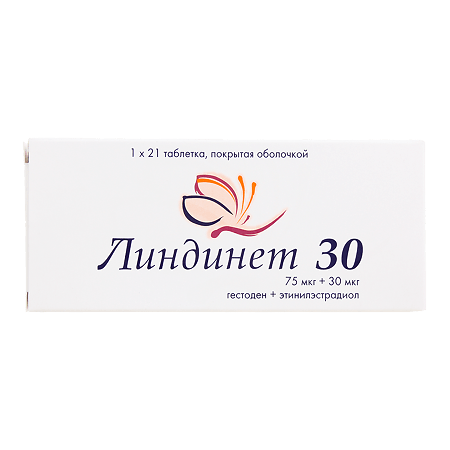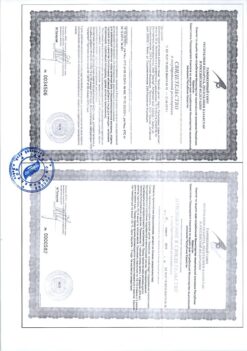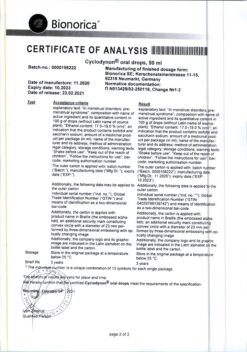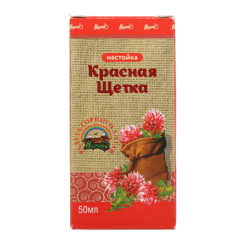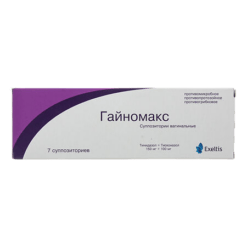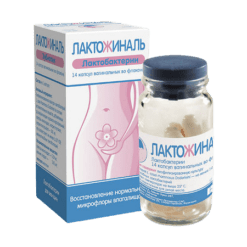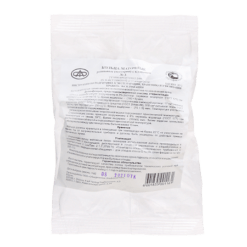No products in the cart.
Lindinet 30,21 pcs.
€23.00 €19.17
EAN: 5997001359778
SKU: 206787
Categories: Contraceptive, Gynecology and Obstetrics, Hormonal, Medicine
Description
Lindinet is a combined medicine, the action of which is caused by the effects of its constituent components. It inhibits pituitary secretion of gonadotropic hormones. The contraceptive effect of the drug is associated with several mechanisms. The estrogenic component of the drug is a highly effective oral drug – ethinyl estradiol (synthetic analog of estradiol, participating together with the corpus luteum hormone in regulation of the menstrual cycle).
The gestagenic component is a derivative of 19-nortestosterone – gestoden, surpassing in power and selectivity of action not only the natural corpus luteum hormone progesterone, but also modern synthetic gestagens (levonorgestrel). Due to high activity, gestoden is used in very low dosages in which it does not exhibit androgenic properties and practically has no effect on lipid and carbohydrate metabolism.
In addition to these central and peripheral mechanisms that prevent the maturation of a fertile egg, the contraceptive effect is due to a reduction in the endometrium’s receptivity to the blastocyst and an increase in the viscosity of the cervical mucus, which makes it relatively impassable to sperm. In addition to its contraceptive effect, when taken regularly, the drug also has a therapeutic effect, normalizing the menstrual cycle and contributing to the prevention of a number of gynecological diseases, including those of tumor nature.
Pharmacokinetics
Gestoden
Intake. When taken orally, it is quickly and completely absorbed. After a single dose, Cmax in plasma is measured after one hour and is 2-4 ng/ml. The bioavailability is about 99%.
Distribution. Binds to albumin and sex hormone binding globulin (hSPH). 1-2% are in the free state, 50-75% specifically bound to HSPH. The increase in HSPH levels due to ethinylestradiol affects gestoden levels, leading to an increase in the HSPH-bound fraction, and a decrease in the albumin-bound fraction. The Vd of gestoden is 0.7-1.4 L/kg.
Metabolism. Consistent with the metabolism of steroids. Average plasma clearance is 0.8-1 ml/min/kg.
Evacuation. Blood levels decrease in two steps. The half-life in the terminal phase is 12-20 h. It is excreted exclusively in the form of metabolites – 60% in the urine, 40% in the faeces. T1/2 of metabolites is about 1 day.
Stable concentration. Pharmacokinetics of gestodenes is largely dependent on the level of hGH. Under the influence of ethinylestradiol, the concentration of hGH in blood increases by a factor of 3; with daily administration of the drug, the plasma level of gestoden increases by a factor of 3-4 and reaches a saturation state in the second half of the cycle.
Ethinylestradiol
Introduction. When taken orally it is absorbed quickly and almost completely. Cmax in the blood is measured after 1-2 h and is 30-80 pg/ml. Absolute bioavailability “60% (due to presystemic conjugation and primary metabolism in the liver).
Distribution. Easily enters nonspecific binding with blood albumin (about 98.5%) and causes increase in HSPH levels. Average Vd is 5-18 l/kg.
Metabolism. Is carried out mainly by aromatic hydroxylation with the formation of large amounts of hydroxylated and methylated metabolites, which are partly in free and partly in conjugated form (glucuronides and sulfates). Plasma clearance “5-13 ml/min/kg.
Evacuation. Serum concentrations decrease in 2 phases. T1/2 in the second phase “16-24 hrs. It is excreted exclusively in the form of metabolites in the ratio of 2:3 with urine and bile. T1/2 of metabolites “1 day.
Stable concentration. Established by day 3-4, with ethinylestradiol levels 20% higher than after a single dose.
Indications
Indications
Contraception.
Pharmacological effect
Pharmacological effect
Lindinet is a combination remedy, the effect of which is determined by the effects of the components included in its composition. Inhibits the pituitary secretion of gonadotropic hormones. The contraceptive effect of the drug is associated with several mechanisms. The estrogenic component of the drug is a highly effective oral drug – ethinyl estradiol (a synthetic analogue of estradiol, which participates together with the corpus luteum hormone in the regulation of the menstrual cycle).
The gestagenic component is a derivative of 19-nortestosterone – gestodene, which is superior in strength and selectivity to not only the natural hormone of the corpus luteum progesterone, but also modern synthetic gestagens (levonorgestrel). Due to its high activity, gestodene is used in very low dosages, in which it does not exhibit androgenic properties and has virtually no effect on lipid and carbohydrate metabolism.
Along with the indicated central and peripheral mechanisms that prevent the maturation of an egg capable of fertilization, the contraceptive effect is due to a decrease in the susceptibility of the endometrium to the blastocyst, as well as an increase in the viscosity of the mucus located in the cervix, which makes it relatively impenetrable for sperm. In addition to the contraceptive effect, the drug, when taken regularly, also has a therapeutic effect, normalizing the menstrual cycle and helping to prevent the development of a number of gynecological diseases, incl. tumor nature.
Pharmacokinetics
Gestodene
Suction. When taken orally, it is quickly and completely absorbed. After taking one dose, Cmax in plasma is measured after an hour and is 2-4 ng/ml. Bioavailability is about 99%.
Distribution. It binds with albumin and sex hormone binding globulin (SHBG). 1–2% are in a free state, 50–75% are specifically bound to SHBG. The increase in SHBG levels caused by ethinyl estradiol affects the level of gestodene, leading to an increase in the SHBG-bound fraction and a decrease in the albumin-bound fraction. Vd of gestodene – 0.7–1.4 l/kg.
Metabolism. Corresponds to steroid metabolism. Average plasma clearance is 0.8–1 ml/min/kg.
Excretion. The blood level decreases in two stages. The half-life in the final phase is 12–20 hours. It is excreted exclusively in the form of metabolites – 60% in urine, 40% in feces. T1/2 of metabolites – approximately 1 day.
Stable concentration. The pharmacokinetics of gestodene largely depends on the level of SHBG. Under the influence of ethinyl estradiol, the concentration of SHBG in the blood increases 3 times; with daily use of the drug, the level of gestodene in plasma increases 3–4 times and in the second half of the cycle reaches a state of saturation.
Ethinyl estradiol
Suction. When taken orally, it is absorbed quickly and almost completely. Cmax in the blood is measured after 1–2 hours and is 30–80 pg/ml. Absolute bioavailability »60% (due to presystemic conjugation and primary metabolism in the liver).
Distribution. Easily enters into a nonspecific relationship with blood albumin (about 98.5%) and causes an increase in SHBG levels. Average Vd – 5–18 l/kg.
Metabolism. It is carried out mainly due to aromatic hydroxylation with the formation of large quantities of hydroxylated and methylated metabolites, partly in free, partly in conjugated form (glucuronides and sulfates). Plasma clearance »5–13 ml/min/kg.
Excretion. Serum concentration decreases in 2 stages. T1/2 in the second phase is 16–24 hours. It is excreted exclusively in the form of metabolites in a ratio of 2:3 with urine and bile. T1/2 of metabolites » 1 day.
Stable concentration. It is established by the 3rd–4th day, while the level of ethinyl estradiol is 20% higher than after taking a single dose.
Special instructions
Special instructions
Before starting to use the drug, it is recommended to collect a detailed family and personal history and subsequently undergo a general medical and gynecological examination every 6 months (examination by a gynecologist, examination of a cytological smear, examination of the mammary glands and liver function, monitoring of blood pressure, cholesterol concentrations in the blood, urine analysis). These studies must be repeated periodically due to the need for timely identification of risk factors or contraindications that have arisen.
The drug is a reliable contraceptive drug – the Pearl index (an indicator of the number of pregnancies occurring during the use of a contraceptive method in 100 women over 1 year) when used correctly is about 0.05. Due to the fact that the contraceptive effect of the drug from the start of administration is fully manifested by the 14th day, it is recommended to additionally use non-hormonal methods of contraception in the first 2 weeks of taking the drug.
In each case, before prescribing hormonal contraceptives, the benefits or possible negative effects of their use are individually assessed. This issue must be discussed with the patient, who, after receiving the necessary information, will make the final decision on the preference for hormonal or any other method of contraception. The woman’s health condition must be carefully monitored.
If any of the following conditions/diseases appear or worsen while taking the drug, you must stop taking the drug and switch to another, non-hormonal method of contraception:
– diseases of the hemostatic system;
– conditions/diseases predisposing to the development of cardiovascular and renal failure;
– epilepsy;
– migraine;
– the risk of developing an estrogen-dependent tumor or estrogen-dependent gynecological diseases;
– diabetes mellitus, not complicated by vascular disorders;
– severe depression (if depression is associated with impaired tryptophan metabolism, then vitamin B6 can be used for correction);
– sickle cell anemia, because in some cases (for example, infections, hypoxia), estrogen-containing drugs for this pathology can provoke thromboembolism;
– the appearance of abnormalities in laboratory tests assessing liver function.
Thromboembolic diseases
Epidemiological studies have shown that there is an association between taking oral hormonal contraceptives and an increased risk of arterial and venous thromboembolic diseases (including myocardial infarction, stroke, deep vein thrombosis of the lower extremities, pulmonary embolism). An increased risk of venous thromboembolic diseases has been proven, but it is significantly less than during pregnancy (60 cases per 100 thousand pregnancies). When using oral contraceptives, arterial or venous thromboembolism of the hepatic, mesenteric, renal or retinal vessels is very rarely observed.
The risk of arterial or venous thromboembolic disease increases:
– with age;
– when smoking (heavy smoking and age over 35 years are risk factors);
– if there is a family history of thromboembolic diseases (for example, parents, brother or sister). If you suspect a genetic predisposition, you should consult a specialist before using the drug;
– for obesity (body mass index above 30);
– for dislipoproteinemia;
– for arterial hypertension;
– for diseases of the heart valves complicated by hemodynamic disorders;
– with atrial fibrillation;
– with diabetes mellitus complicated by vascular lesions;
– with prolonged immobilization, after major surgery, surgery on the lower extremities, severe trauma.
In these cases, temporary cessation of use of the drug is assumed. It is advisable to stop no later than 4 weeks before surgery, and resume no earlier than 2 weeks after remobilization.
The risk of venous thromboembolic diseases increases in women after childbirth.
Diseases such as diabetes mellitus, SLE, hemolytic uremic syndrome, Crohn’s disease, ulcerative colitis, and sickle cell anemia increase the risk of developing venous thromboembolic diseases.
Biochemical abnormalities such as resistance to activated protein C, hyperhomocysteinemia, protein C and S deficiency, antithrombin III deficiency, and the presence of antiphospholipid antibodies increase the risk of arterial or venous thromboembolic diseases.
When assessing the benefit/risk ratio of taking the drug, it must be borne in mind that targeted treatment of this condition reduces the risk of thromboembolism.
Signs of thromboembolism are:
– sudden chest pain that radiates to the left arm;
– sudden shortness of breath;
– any unusually severe headache that continues for a long time or appears for the first time, especially when combined with sudden complete or partial loss of vision or diplopia, aphasia, dizziness, collapse, focal epilepsy, weakness or severe numbness of half the body, movement disorders, severe unilateral pain in the calf muscle, acute abdomen.
Tumor diseases
Some studies have reported an increased incidence of cervical cancer in women who took hormonal contraceptives for a long time, but the results of the studies are inconsistent. Sexual behavior, infection with the human papillomavirus and other factors play a significant role in the development of cervical cancer.
A meta-analysis of 54 epidemiological studies found that there was a relative increase in the risk of breast cancer among women taking oral hormonal contraceptives, but the higher detection rate of breast cancer may have been associated with more regular medical screening. Breast cancer is rare among women under 40, whether they are taking hormonal birth control or not, and increases with age. Taking pills can be considered one of many risk factors. However, women should be made aware of the possible risk of developing breast cancer based on a benefit-risk assessment (protection against ovarian, endometrial and colon cancer).
There are few reports of the development of benign or malignant liver tumors in women taking hormonal contraceptives for a long time. This should be kept in mind when diagnosing abdominal pain, which may be associated with an increase in liver size or intra-abdominal bleeding.
The woman should be warned that the drug does not protect against HIV infection (AIDS) and other sexually transmitted diseases.
The effectiveness of the drug may be reduced in the following cases: missed pills, vomiting and diarrhea, simultaneous use of other drugs that reduce the effectiveness of birth control pills.
If the patient is simultaneously taking another drug that may reduce the effectiveness of birth control pills, additional methods of contraception should be used.
The effectiveness of the drug may decrease if, after several months of their use, irregular, spotting or breakthrough bleeding appears, in such cases it is advisable to continue taking the tablets until they run out in the next package. If at the end of the 2nd cycle menstrual-like bleeding does not begin or acyclic bleeding does not stop, you should stop taking the pills and resume it only after pregnancy has been ruled out.
Chloasma
Chloasma can occasionally occur in women who have a history of it during pregnancy. Those women who are at risk of developing chloasma should avoid contact with sunlight or UV rays while taking the pills.
Changes in laboratory parameters
Under the influence of oral contraceptive pills, due to the estrogen component, the level of some laboratory parameters (functional indicators of the liver, kidneys, adrenal glands, thyroid gland, hemostasis indicators, levels of lipoproteins and transport proteins) may change.
After acute viral hepatitis, it should be taken after normalization of liver function (no earlier than 6 months). In case of diarrhea or intestinal disorders, vomiting, the contraceptive effect may decrease (without stopping the drug, it is necessary to use additional non-hormonal methods of contraception). Women who smoke have an increased risk of developing vascular diseases with serious consequences (myocardial infarction, stroke). The risk depends on age (especially in women over 35 years of age) and the number of cigarettes smoked. During lactation, milk secretion may decrease; in small quantities, the components of the drug are excreted in breast milk.
The effect of the drug on the ability to drive a car and operate machinery. Studies have not been conducted to study the possible effect of Lindinet 30 on the ability to drive a car or other machines.
Active ingredient
Active ingredient
Gestodene, Ethinylestradiol
Composition
Composition
1 tablet contains:
active substances:
ethinyl estradiol 30 mcg;
gestodene 75 mcg;
excipients:
sodium calcium edetate,
magnesium stearate, colloidal silicon anhydrous,
povidone,
corn starch,
lactose monohydrate;
Shell composition:
D+S yellow N 10 C.I. 47005, E104,
povidone,
titanium oxide C.I. 7791, E171,
macrogol 6000;
talc,
calcium carbonate,
sucrose.
Pregnancy
Pregnancy
The drug is contraindicated for use during pregnancy.
If it is necessary to prescribe the drug during lactation, the issue of stopping breastfeeding should be decided.
The active substances of the drug are excreted in small quantities into breast milk, affecting the quantity and quality of milk.
Contraindications
Contraindications
individual hypersensitivity to the drug or its components;
the presence of severe or multiple risk factors for venous or arterial thrombosis (including complicated lesions of the heart valve apparatus, atrial fibrillation, cerebral vascular disease or coronary artery disease);
uncontrolled moderate or severe arterial hypertension with blood pressure 160/100 mmHg. Art. and more);
precursors of thrombosis (including transient ischemic attack, angina), incl. in the anamnesis;
migraine with focal neurological symptoms, incl. in the anamnesis;
venous or arterial thrombosis/thromboembolism (including deep vein thrombosis of the leg, pulmonary embolism, myocardial infarction, stroke) currently or in history;
the presence of venous thromboembolism in relatives;
major surgery with prolonged immobilization;
diabetes mellitus (with the presence of angiopathy);
pancreatitis (including a history), accompanied by severe hypertriglyceridemia;
dyslipidemia;
severe liver diseases, cholestatic jaundice (including during pregnancy), hepatitis, incl. history (before normalization of functional and laboratory parameters and within 3 months after these parameters return to normal);
jaundice due to taking drugs containing steroids;
gallstone disease currently or in history;
Gilbert, Dubin-Johnson, Rotor syndrome;
liver tumors (including history);
severe itching, otosclerosis or progression of otosclerosis during a previous pregnancy or while taking corticosteroids;
hormone-dependent malignant neoplasms of the genital organs and mammary glands (including suspicion of them);
vaginal bleeding of unknown etiology;
smoking over the age of 35 (more than 15 cigarettes per day);
pregnancy or suspicion of it;
lactation.
With caution: conditions that increase the risk of developing venous or arterial thrombosis/thromboembolism (age over 35 years, smoking, hereditary predisposition to thrombosis – thrombosis, myocardial infarction or cerebrovascular accident at a young age in one of the immediate family); hemolytic uremic syndrome; hereditary angioedema; liver diseases; diseases that first appeared or worsened during pregnancy or against the background of previous use of sex hormones (including porphyria, herpes of pregnant women, minor chorea – Sydenham’s disease, Sydenham’s chorea, chloasma); obesity (body mass index more than 30); dyslipoproteinemia; arterial hypertension; migraine; epilepsy; valvular heart defects; atrial fibrillation; long-term immobilization; extensive surgery; surgery on the lower extremities; severe injury; varicose veins and superficial thrombophlebitis; postpartum period (non-lactating women – 21 days after birth; lactating women – after completion of the lactation period); presence of severe depression, incl. in the anamnesis; changes in biochemical parameters (activated protein C resistance, hyperhomocysteinemia, antithrombin III deficiency, protein C or S deficiency, antiphospholipid antibodies, including antibodies to cardiolipin, lupus anticoagulant); diabetes mellitus not complicated by vascular disorders; systemic lupus erythematosus (SLE); Crohn’s disease; ulcerative colitis; sickle cell anemia; hypertriglyceridemia (including family history); acute and chronic liver diseases.
Side Effects
Side Effects
Side effects that require immediate discontinuation of the drug:
– arterial hypertension;
– hemolytic-uremic syndrome;
– porphyria;
– hearing loss caused by otosclerosis.
Rarely encountered – arterial and venous thromboembolism (including myocardial infarction, stroke, deep vein thrombosis of the lower extremities, pulmonary embolism); exacerbation of reactive SLE.
Very rare – arterial or venous thromboembolism of the hepatic, mesenteric, renal, retinal arteries and veins; Sydenham’s chorea (passing after discontinuation of the drug).
Other side effects, less severe, but more common – the advisability of continuing to use the drug is decided individually after consultation with a doctor, based on the benefit/risk ratio.
From the reproductive system: acyclic bleeding/spotting from the vagina, amenorrhea after discontinuation of the drug, changes in the state of vaginal mucus, development of inflammatory processes in the vagina (for example, candidiasis), changes in libido.
From the mammary glands: tension, pain, enlargement of the mammary glands, galactorrhea.
From the gastrointestinal tract and hepatobiliary system: nausea, vomiting, diarrhea, epigastric pain, Crohn’s disease, ulcerative colitis, hepatitis, liver adenoma, the occurrence or exacerbation of jaundice and/or itching associated with cholestasis, cholelithiasis.
Skin: erythema nodosum/exudative, rash, chloasma, increased hair loss.
From the central nervous system: headache, migraine, mood changes, depressive states.
Metabolic disorders: fluid retention in the body, change (increase) in body weight, increased triglycerides and blood sugar, decreased tolerance to carbohydrates.
From the senses: hearing loss, increased sensitivity of the cornea when wearing contact lenses.
Other: allergic reactions.
Interaction
Interaction
The contraceptive effect of oral contraceptives is reduced with simultaneous use of rifampicin, breakthrough bleeding and menstrual irregularities become more frequent. Similar, but less studied, interactions exist between contraceptives and carbamazepine, primidone, barbiturates, phenylbutazone, phenytoin and presumably griseofulvin, ampicillin and tetracyclines.
During treatment with the above drugs, simultaneously with oral contraception, it is recommended to use an additional method of contraception (condom, spermicidal gel). After completing the course of treatment, the use of an additional method of contraception should be continued for 7 days, in the case of treatment with rifampicin – for 4 weeks.
Interactions associated with drug absorption
During diarrhea, the absorption of hormones decreases (due to increased intestinal motility). Any drug that shortens the time a hormonal agent remains in the large intestine leads to low concentrations of the hormone in the blood.
Interactions related to drug metabolism
Intestinal wall. Drugs that undergo sulfation in the intestinal wall like ethinyl estradiol (for example, ascorbic acid) inhibit metabolism and increase the bioavailability of ethinyl estradiol.
Metabolism in the liver. Inducers of microsomal liver enzymes reduce the level of ethinyl estradiol in the blood plasma (rifampicin, barbiturates, phenylbutazone, phenytoin, griseofulvin, topiramate, hydantoin, felbamate, rifabutin, oxcarbazepine). Liver enzyme blockers (itraconazole, fluconazole) increase the level of ethinyl estradiol in the blood plasma.
Effect on intrahepatic circulation. Some antibiotics (for example, ampicillin, tetracycline), by interfering with the intrahepatic circulation of estrogens, reduce the level of ethinyl estradiol in plasma.
Effect on the metabolism of other drugs
By blocking liver enzymes or accelerating conjugation in the liver, mainly increasing glucuronidation, ethinyl estradiol affects the metabolism of other drugs (for example, cyclosporine, theophylline), leading to an increase or decrease in their plasma concentrations.
The simultaneous use of St. John’s wort (Hypericum perforatum) with Lindinet 20 tablets is not recommended (due to a possible decrease in the contraceptive effect of the active substances of the contraceptive, which may be accompanied by breakthrough bleeding and unwanted pregnancy). St. John’s wort activates liver enzymes; after stopping the use of St. John’s wort, the effect of enzyme induction may persist for the next 2 weeks.
Concomitant use of ritonavir and a combined contraceptive is associated with a 41% decrease in the mean AUC of ethinyl estradiol. During treatment with ritonavir, it is recommended to use a drug with a higher ethinyl estradiol content or a non-hormonal method of contraception. It may be necessary to adjust the dosage regimen when using hypoglycemic agents, because oral contraceptives may decrease carbohydrate tolerance and increase the need for insulin or oral antidiabetic agents.
Overdose
Overdose
Taking large doses of the contraceptive was not accompanied by the development of severe symptoms.
Symptoms: nausea, vomiting, in young girls, slight vaginal bleeding.
Treatment: symptomatic, there is no specific antidote.
Storage conditions
Storage conditions
In a dry place, protected from light, at a temperature not exceeding 25 °C
Shelf life
Shelf life
3 years
Manufacturer
Manufacturer
Gedeon Richter, Hungary
Additional information
| Shelf life | 3 years |
|---|---|
| Conditions of storage | In a dry, light-protected place at a temperature not exceeding 25 °C |
| Manufacturer | Gedeon Richter, Hungary |
| Medication form | pills |
| Brand | Gedeon Richter |
Related products
Gynecology and Obstetrics
Buy Lindinet 30,21 pcs. with delivery to USA, UK, Europe and over 120 other countries.

